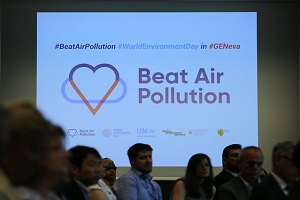
Air pollution is by far the world’s largest single environmental health risk and cause of death by cancer. Dubbed “the invisible killer”, it is estimated to be responsible for about 7 million deaths annually – a situation that in reality could be much worse, as indicated by recent scientific studies putting the yearly death toll from outdoor air pollution alone at a staggering 8.8 million.
Let’s not forget, though, that air pollution does not only take human lives – with an associated economic cost at or above 20% of national GDP in 10 countries of the Pan-European region – but that it can also wreak havoc on plants, animals and entire ecosystems. The notorious die-back of forests – or Waldsterben, as it came to be known – that was a result of air pollution-induced acid rain motivated governments of the region to sign an international legally-binding contract back in 1979: the UNECE Convention on Long-range Transboundary Air Pollution (Air Convention).
40 years on, the Air Convention remains the only regional policy solution of its kind anywhere in the world. This regional approach is key precisely because air pollutants cross national borders and can travel thousands of kilometres.
Under the Convention, 51 countries in Europe – including all EU Member States – and North America are cooperating to reduce deadly air pollution. Its 8 protocols setting legally binding emission reduction commitments for various pollutants, its solid science-policy interface, its effective compliance mechanism, its capacity-building programme, and its outreach beyond the UNECE region make the Convention today more relevant than ever.
Collective efforts under the Convention have achieved impressive results:
- Emissions of harmful substances including particulate matter and sulphur have been cut by 30-80% since 1990 in Europe and 30-40% in North America.
- In Europe, these measures account for 1 additional year of life expectancy, and prevent 600,000 premature deaths annually.
- Soil acidification has been halted in most parts of Europe, and declining acidification in lakes has led to fish stocks recovering in areas where they had largely disappeared.
- Strengthened climate action thanks to the Convention’s binding emission reduction commitments for “short-lived climate forcers”. The amended Gothenburg Protocol – expected to enter into force later this year – specifically includes black carbon (or soot) - which is 680 times more heat trapping than CO2 - as a component of fine particulate matter.
But despite its successes, we still have a long way to go to protect our health and the environment from the effects of air pollution, within the UNECE region and around the world. The growing momentum of global movements including “Fridays-for-Future” remind us that we are still using our atmosphere as if it were a big sewer.
On World Environment Day, celebrated annually on 5 June, we speak up for our environment. Under this year’s theme of “Beat Air Pollution”, the main celebrations are taking place in China.
In parallel, Geneva celebrations this week featured a high-level dialogue on ‘Beat Air Pollution: the need for a multi-level response’ organized within the Geneva Environment Network framework.
Highlighting the achievements of the Convention, UNECE Executive Secretary Olga Algayerova stressed that “the problem of air pollution cannot be solved at the local or national level alone. 40 years of experience of the Air Convention have shown that regional cooperation is key to reduce air pollutant emissions.” Calling on Governments, organizations and other stakeholders to work together to beat air pollution, she further emphasized that while the Air Convention is a regional instrument, other regions are looking to UNECE for advice. “We believe that the Convention as a framework is a great model that could be replicated in other regions. UNECE is happy to share its lessons learnt”.
Tackling air pollution requires action at all levels and in all sectors. As part of its integrated support to countries’ implementation of the 2030 Agenda for Sustainable Development, UNECE also contributes to reducing harmful air emissions from transport – for example by driving progress in UN vehicle regulations on emissions and improved fuel quality and by supporting the development of less polluting technologies including electric mobility, hybrid and hydrogen. UNECE is also assisting countries’ sustainable energy transition, helping to limit emissions from the energy sector and support the shift to green and renewable sources.
Photo credit: BRS MEAS